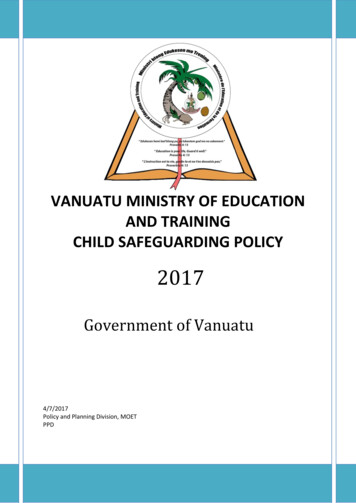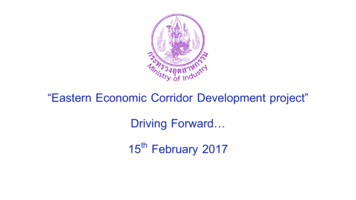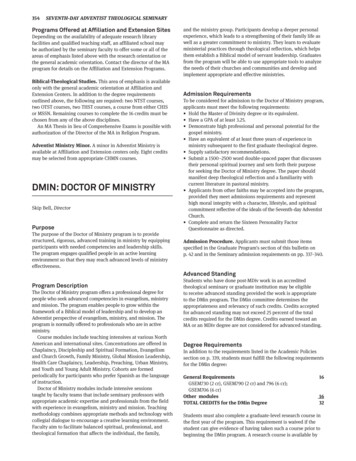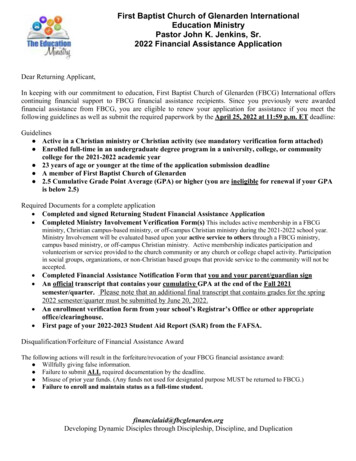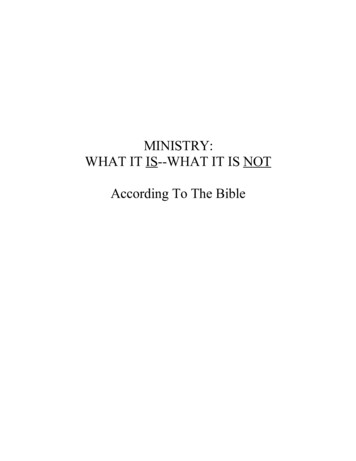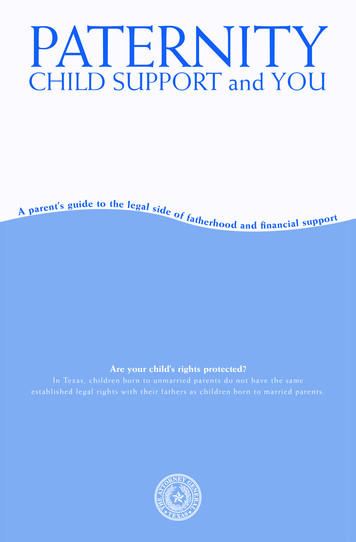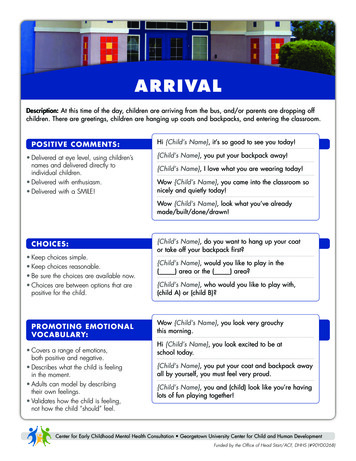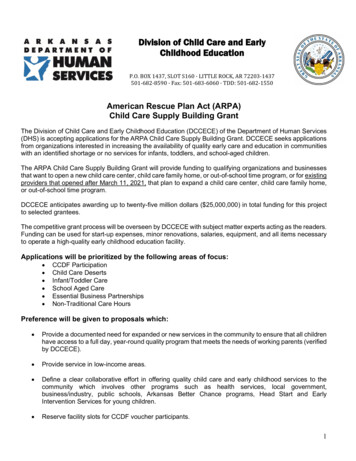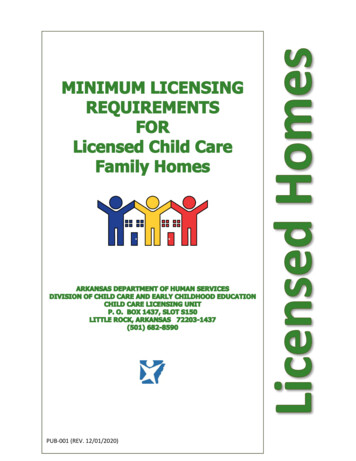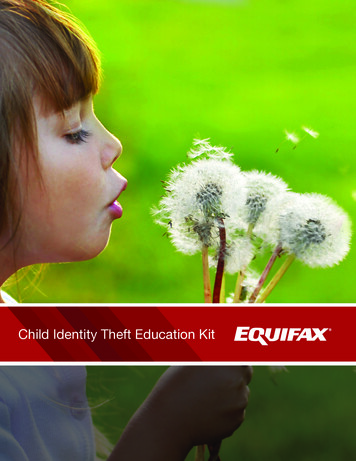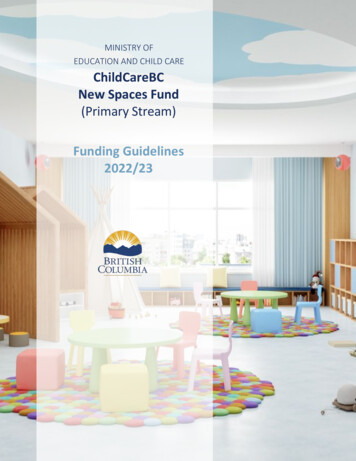
Transcription
MINISTRY OFEDUCATION AND CHILD CAREChildCareBCNew Spaces Fund(Primary Stream)Funding Guidelines2022/23
These funding guidelines are effective May 31, 2022.PLEASE NOTEThe Ministry will assess all applications received according tothe selection requirements and the principles contained in thisdocument as described in Section 5.Ensure you are using the current application form. Check thatthe application is labelled 2022/2023.Please contact the Ministry if you have questions atMCF.CCCF@gov.bc.ca or 1-888-338-6622 (option 5).ChildCareBC New Spaces Fund: Funding Guidelines – 2022/23 Page 2
Contents1. Introduction. 41.1 Summary of Key Changes for 2022/23 . 42. Who Can Apply? . 52.1 Eligible Organizations . 52.2 Ineligible Organizations and Projects . 53. Priority Areas . 64. Funding . 74.1 Funding Award Commitment . 94.1.1 Cost per Space . 94.1.2 Contingency . 94.2 Requirements . 105. Applicant Selection and Funding Process . 125.1 Call for Applications . 125.2 Evaluation Criteria . 136. Eligible and Ineligible Project Costs . 156.1 Eligible Project Costs . 156.2 Ineligible Project Costs . 167. How to Apply . 18Appendix A – Terms & Conditions . 21Appendix B – Written Quotes . 27Appendix C – Definitions . 28ChildCareBC New Spaces Fund: Funding Guidelines – 2022/23 Page 3
1. IntroductionSince launching in July 2018, the ChildCareBC New Spaces Fund has supported and acceleratedcreation of new licensed child care, helping to ensure quality, accessible, inclusive, andaffordable child care is available to every family throughout BC who wants it, when they need it,at a price they can afford.In 2022/23, the Ministry of Education and Child Care (the Ministry) will continue to support child carespace creation projects that maximize the number of spaces in high-need areas throughout the provincethrough the New Spaces Fund. The program provides funding for long-term community investments runby public and not-for-profit organizations (societies), increasing availability of infant-toddler and schoolage care, and supporting accessible and inclusive builds that welcome children with diverse needs.1.1 Summary of Key Changes for 2022/23In 2022/23 the Ministry is focusing space creation investment on expanding quality, inclusivecommunity-based child care in areas with the greatest needs, in alignment with provincialpriorities and commitments under the Canada Wide Early Learning and Child Care Agreement.Key changes for 2022/23 include: An open intake for applications starting May 31st, 2022. The intake will close whenfunding runs out or at the end of the 2022/23 funding cycle. Applicants areencouraged to apply by January 2023 to have their applications considered. Thewebsite will be updated with closure dates. Removal of maximum Provincial Funding Amounts to support larger space creationprojects, with prioritization for projects with a cost per space of 40,000 or less Increased priority for projects creating infant-toddler child care spaces Increased priority on school-age space creation, including a new application streamfor BC School Districts, First Nation Schools, First Nation Independent Schools, andNot-For-Profit Independent Schools creating new spaces under the School Age Careon School Grounds licence category type 1 Added eligibility for the funding of consulting services incurred up to 12 months priorto entering a Funding Agreement New requirement for projects to include a minimum 10% contingency fund1If you are one of the listed eligible organizations and you are only creating licensed child care spaces under the School Age Care onSchool Grounds licence category with a cost per space below 40K/space, you may apply under the School Age Care on School Groundsapplication stream.ChildCareBC New Spaces Fund: Funding Guidelines – 2022/23 Page 4
2. Who Can Apply?2.1 Eligible Organizations Public sector organizations including:o Local governmentso School districtso Health authoritieso Public post-secondary institutionso Crown corporationsIndigenous governmentsNot-for-profit organizations (societies) and Indigenous not-for-profit organizations (societies)Eligible organizations must: Be in good standing with the Ministry (i.e., does not have an outstanding debt owing to theMinistry) Be in good standing with the BC Corporate Registry (where applicable) Apply and enrol in Child Care Operating Funding (CCOF) program, the Early Childhood EducatorWage Enhancement (ECE-WE) and, where eligible, enrol in the Child Care Fee Reduction Initiative(CCFRI) and/or any future BC Government operating funding initiatives for the project’s fundingaward commitment period once the spaces become operational (Section 4.1)2.2 Ineligible Organizations and ProjectsIneligible organizations include: For-Profit Organizations, including but not limited to, partnerships, sole proprietors,benefit companies, community contribution companies, limited companies, andincorporated companies Member-funded not-for-profit societies Those who have a history of ongoing non-compliance (infractions/violations) under theCommunity Care and Assisted Living Act and Child Care Licensing RegulationIneligible projects or components include those for: Child care spaces not eligible for licensing Child care spaces for the following licence types: occasional child care, child minding, recreationalcare, residential care, preschool, family, or in-home multi-age2 A project that is fully completed prior to signing the Funding Agreement Relocating without the intent of creating new licensed child care spaces Projects that do not involve creating new licensed child care spaces2Fully completed projects are those that are licensed and ready to begin operation.ChildCareBC New Spaces Fund: Funding Guidelines – 2022/23 Page 5
3. Priority AreasThe New Spaces Fund supports the creation of licensed child care spaces, aiming to increaseaccess to quality, inclusive child care throughout BC. The Ministry will prioritize applicationsproposing projects that deliver on the following key priorities: Creation of infant-toddler child care spacesCreation of school-age spacesCreation of spaces serving priority populations including:o Low-income familieso Children with support needso Indigenous children and familieso Black and other children and families of colouro Francophone childreno Families new to Canadao Young parents (25 years and under)Creation of spaces co-located with other community or family services, such as on school grounds(including K-12 and public post-secondary) 3Creation of fully inclusive and accessible child care spaces that allow children of all abilities toparticipate meaningfully (i.e., accessible physical design and application of program inclusionpolicy)Projects with a provincial cost per space of 40,000 or less to ensure the fund creates as manyspaces in as many communities as possibleFor more information on the priority areas, please refer to the Program FAQs and theApplication Resource.3For projects on school grounds or district-owned land, the school district must apply.ChildCareBC New Spaces Fund: Funding Guidelines – 2022/23 Page 6
4. FundingChildCareBC New Spaces Fund grants are provided under the Child Care BC ActGrant funding under this program is provided at the Ministry’s discretion and is subject tobudget availability. For successful applicants, funding may be provided according to Table 1below. The Ministry will provide successful applicants a Provincial Funding Amount for theproject, based on the eligible project costs (Section 6.1). Any ineligible project costs (Section6.2) will be the financial responsibility of the applicant. The applicant’s level of contributiondepends on the type of organization (Table 1 below).Table 1: Contribution Percentages by Applicant TypeRequired OrganizationContribution as a % ofTOTAL ProjectCostsProvincialContribution as a % ofELIGIBLEProject CostsPublic sector organizations andIndigenousGovernments0%100%Indigenous Not-For-ProfitOrganizations (Societies)0%100%Not-For-Profit Organizations (Societies)(including Not-For-Profit Child CareProviders, and Child DevelopmentCentres)10%90%Applicant TypeNot-for-profit organizations (societies) must make the minimum required organizationcontribution. However, organizations may contribute more than the minimum requiredorganization contribution. Applicant contributions may include funding from other sources,such as monetary gifts, credit sources, bank loans, and in-kind contributions. OtherChildCareBC funding (e.g., ChildCareBC Maintenance Fund) will not be considered as part ofan applicant’s required organization contribution.The Provincial Funding Amount will be considered for the total eligible project costs at a singlephysical location 4.For example, if the organization was a not-for-profit organization (society), the Ministry would4Projects occupying the same physical location are considered as a single project.ChildCareBC New Spaces Fund: Funding Guidelines – 2022/23 Page 7
provide 90% of the total eligible project costs. The minimum required organization contributionwould be 10% of the total project costs.For a 1,500,000 Project, with eligible project costs totaling 1,000,000 and ineligible projectcosts totaling 500,000: The provincial contribution considered would be 900,000 (i.e., 90% of the 1,000,000eligible project costs)The organization would be required to make a minimum contribution of 150,000(i.e., 10% of the 1,500,000 total project costs)To cover the remaining project costs of 450,000 ( 1,500,000 total minus 900,000provincial contribution minus 150,000 required organization contribution), theorganization may contribute more than the 150,000 minimum required organizationcontribution themselves or seek funding from additional sourcesProof of all financial contributions to the project are required, in this example, theorganization must show proof of a financial contribution of 600,000This example is repeated in Table 2 below:Table 2: Examples of Funding ContributionsThe project applicant is a not-for-profit organization. Their total project cost is 1,500,000; however,only 1,000,000 of that are eligible projects costs. In this scenario, the contributions would be as ovincialContribution(90% ofeligible costs)Required OrganizationContribution(10% of total projectcosts)Proof Organization hasadditional required fundingfrom other sources (remainingamount of total project costs) 1,500,000 1,000,000 900,000 150,000 450,000The applicant must show proof of theRequired Organization Contribution, andproof of additional funding for the remainingamount of total project costs. 600,000ChildCareBC New Spaces Fund: Funding Guidelines – 2022/23 Page 8
4.1 Funding Award CommitmentRecipients of funding are required to adhere to the following funding award commitments:Table 3: Funding Award Commitment Period by Funding Award AmountAmount of FundingAwarded to the ProjectFunding Award Commitment PeriodUnder 50,000Commit to continuing the Child Care Operation for a minimum of 5yearsBetween 50,000 and 499,999Commit to continuing the Child Care Operation for a minimum of 10yearsBetween 500,000 and 2,999,999Commit to continuing the Child Care Operation for a minimum of 15years 3 million and aboveCommit to continuing the Child Care Operation for a minimum of 20years; higher funding amounts will have higher commitmentsdependent on total funding awardedIf the child care operation fails to meet the minimum funding award commitment set out in theFunding Agreement with the Ministry, the recipient may be required to repay some or all of thefunding provided.4.1.1 Cost per SpaceThe Ministry is prioritizing projects with a provincial cost per space of 40,000 or less.Projects with a provincial cost per space over 40,000 may be considered, at thediscretion of the Ministry and dependent on Ministry budget considerations, ifcomponents of the project are associated with known cost drivers (e.g., unique sitedevelopment requirements, building in rural/remote locations) and the project performshigher on evaluation criteria (Section 5.2 Evaluation Criteria). Projects with a cost perspace over 40,000 will also be subject to increased Ministry evaluation timelines.4.1.2 ContingencyTo mitigate potential budget and project risks, organizations are required to include a contingencyfund in their project budget. For an application to be considered for funding, the project mustinclude a contingency fund that represents at least 10% of the total project costs related to the childcare build. For example, if the total project costs related to the child care build (i.e., both ineligibleand eligible project costs) equals 100,000, the minimum contingency fund would equal 10,000.ChildCareBC New Spaces Fund: Funding Guidelines – 2022/23 Page 9
4.2 RequirementsOrganizations that are approved for and receive funding through the ChildCareBC New Spaces Fundare required to ensure their proposed project or facility, or that of their Authorized Operator: Comply with licensing requirements under the Child Care Licensing Regulation aspart of the Community Care and Assisted Living ActAdhere to local bylaw requirementsSubmit a Financial Reconciliation Package for the project to the Ministry within 60days of project completion, or such longer period as requested in writing andaccepted by the MinistryOffer and provide child care service to families receiving the Affordable Child CareBenefitApply for and enrol in the Child Care Operating Funding (CCOF) program andin the Child Care Fee Reduction Initiative (CCFRI), or any future BCGovernment operating funding initiatives, where eligible and approved, eachterm for the minimum funding award commitment period of the projectonce the spaces become operationalApply for and enrol in the ECE Wage Enhancement (ECE-WE), where eligible andapproved, each term for the minimum funding award commitment period of theproject once the spaces become operationalFunding recipients should allow for enough time to complete all the requirementslisted in this section to receive the final installment of their funding. Meeting theserequirements will require both: Working with their regional health authority’s Community Care Facility Licensingprogram to obtain or update their Community Care and Assisted Living Act facilitylicenceApplying and being approved for enrolment in CCOF, the CCFRI, and ECE-WE, or any futureBC Government operating funding initiatives where eligible and approvedIf, following payment of the final installment, a recipient becomes ineligible, or withdrawsfrom CCOF, the CCFRI, and ECE-WE, or any future BC Government operating fundinginitiatives, where eligible and approved, prior to the project’s minimum funding awardcommitment period, the recipient will be required to make a repayment of their NewSpaces Fund grant to the Ministry, in alignment with the terms of the New Spaces FundingAgreement. Additionally, the recipient will be subject to any withdrawal penalties thatapply under the terms of their CCOF/CCFRI/ECE-WE funding agreements, or any future BCGovernment operating funding initiatives, with the Ministry, where eligible and approved.ChildCareBC New Spaces Fund: Funding Guidelines – 2022/23 Page 10
Recipients of the ChildCareBC New Spaces Fund are responsible for ensuring any AuthorizedOperator operating the child care facility will be able to meet the eligibility requirements forCCOF, the CCFRI, and ECE-WE, where eligible and approved. Recipients are also responsiblefor ensuring sub-contractors remain current on the policy requirements for each program,or any future BC Government operating funding initiatives. Recipients remain ultimatelyresponsible for ensuring that all obligations under the New Spaces Funding Agreementcontinue to be met, regardless of whether it is the recipient that is running the child careoperation or a contracted third party.ChildCareBC New Spaces Fund: Funding Guidelines – 2022/23 Page 11
5. Applicant Selection and Funding Process5.1 Call for Applications1. Applicants submit a completed application form with mandatory supportingdocumentation (Table 4). Applications will be accepted starting on May 31, 2022.Applicants are encouraged to submit a complete application by January 2023 toensure the application can be considered prior to fiscal year end, as fundingapproval is subject to budget availability.2. The Ministry will review applications in the order in which they are received. 5 Duringthis internal review, the Ministry will screen applications for missing information 6 andmay provide applicants with an opportunity to address deficiencies according to therectification process, depending on the nature of the deficiency (Appendix A, 8.15).a. Following any rectification, the Ministry evaluates the applications 7 based on theinformation set out in the Evaluation Criteria (Section 5.2) and any otherprinciples, preferences, or requirements set out in these guidelines. TheMinistry, at its discretion, then selects the successful applicants.b. In addition to requiring applicants to rectify deficiencies, the Ministry reservesthe right to perform additional investigations and to request additionalinformation 8 as it deems necessary as part of the application review process.Failure on the part of an applicant to provide additional information to theMinistry when requested could result in a rejection of their application.3. All applicants will be notified of the outcome of their application, with successfulapplicants invited to enter into a New Spaces Funding Agreement with the Ministry.4. Once the New Spaces Funding Agreement is complete, the recipient will receive theNew Spaces funding according to the funding disbursement schedule and will berequired to start the project.5. If the Ministry rejects an application for New Spaces Funding, the unsuccessfulapplicant may request the Ministry to provide the rationale for the decision.5Timelines for approval may vary depending on application completeness, project complexity and cost considerations.Inaccurate information will not be rectified. Only missing information will be rectified.7Applications will not be evaluated until they are complete. For projects requiring rectification, evaluation does not begin untilrectification is complete.8Additional information may include, but is not limited to, seeking and/or confirming information from other government ministries,where applicable.6ChildCareBC New Spaces Fund: Funding Guidelines – 2022/23 Page 12
5.2 Evaluation CriteriaApplications will be evaluated based on (but not limited to) the following criteria:9 A completed application , including all mandatory supporting documentation (Table 4) Project viability, as determined by the Ministry (Appendix A, 8.18) Readiness to begin the project, such as ability to begin construction within 6 months of approvalof New Spaces Funding (exceptions may be considered at the Ministry’s discretion) Financial considerations, including:o Eligibility and reasonability of project costso Estimated provincial cost per space 10o Portion of project costs committed to administrative, consulting, and professionalfees and/or expenses 11o Sources of funds for all financial contributionso Contingency fundingo Project risk mitigation strategy, including risk of cost escalations Ministry-assessed project risks Demonstration of the project’s ability to:o Meet the priority areas listed in Section 3o Satisfy the requirements set out in Section 4.2o Meet the Province’s child care objectives (Appendix A, 8.19) Child care build and design considerations, such as:o Ownership or lease status of the identified facilityo Experience of applicant or identified contractor/project management team managingcapital build projectso Alignment with Green Building Standardso Electrification of primary space and water heatingo Construction with one or more major structural system (e.g. floor, roof, vertical or lateralload-bearing) out of mass timber Child care operations considerations, such as:o Whether the applicant will be directly operating the child care spaces or commit topartnering with a not-for-profit operator 12o Retention plan if the project is expanding a facility with existing licensed child care spaceso Experience of the identified operator in operating a licensed child care facility and/orcommunity-based programso Implementation of quality and environmental assessment toolso Staffing plan/considerations9Applications will be evaluated on the accuracy and validity of the information provided; an application is not considered complete untilthe rectification period is over (if applicable).10Priority will be given to projects with a provincial cost per space of 40,000 or less.11Professional, administrative, and consulting services must not exceed 15% of the overall project costs.12Proposed partnering with a for-profit operator will only be considered in extenuating circumstances and the applicant must provide astrong rationale (for more details, see Application Resource).ChildCareBC New Spaces Fund: Funding Guidelines – 2022/23 Page 13
o Demonstrated consideration of the affordability of child care serviceso Creation of spaces offered outside of core business hours (i.e., before 6 a.m. and/or after7 p.m., weekends, and/or overnight)Child care needs, such as:o Creation of licensed child care spaces that align with the community’s childcare needs, as demonstrated in the submitted Community Child Care Plan orChild Care Needs Assessmento Community support for the project as demonstrated by communityengagemento Creation of spaces in underserved communities (based on Ministry data)ChildCareBC New Spaces Fund: Funding Guidelines – 2022/23 Page 14
6. Eligible and Ineligible Project CostsNew Spaces Funding will be considered for: Building a new child care facility The purchase, assembly, and installation of a modular or portable building for useas a child care facility Site development costs for use as a child care facility Renovation of an existing building, space, or classroom for use as a child carefacility Purchase of equipment or other capital costs related to obtaining a licence to operate achild care facilityIneligible project costs will not be funded by the Ministry. The Ministry has the sole discretionand reserves the right to determine projects and items that may receive funding. Costsattributed to professional, administrative, and consulting services may be up to a maximum of15% of the total project costs. Exemptions will only be considered in exceptional circumstances,at the discretion of the Ministry.6.1 Eligible Project CostsEligible project costs include (but are not limited to) the following: Direct costs related to the development and implementation of the project(s) Consulting services, including: 13o Project management 14o Design/engineering costs and site evaluationso Project-related professional fees (e.g., architectural, accountant), exceptlegal costs o Business planning development (e.g., business case model and analysis)Infrastructure costs (e.g., water, sewer, road, sidewalk, etc.)Minimum 10% contingency fund 15GST and PST as part of eligible project costs, if applicableCapital purchases that are essential to project implementation, including:13Consulting services incurred up to 12 months prior to entering a Funding Agreement may be eligible for funding, at the discretion ofthe Ministry. Professional, administrative, and consulting services must not exceed 15% of the overall project costs.14Project managers must be contracted out and must be a third party at arm’s length from the project and applicant for their fees to beeligible for funding.15To be considered for funding, applicants must ensure their project budget includes a contingency fund equal to at least 10% of thetotal project costs related to the child care build.ChildCareBC New Spaces Fund: Funding Guidelines – 2022/23 Page 15
ooooo Office equipmentMajor appliances (e.g., fridge, stove, dishwasher, etc.)Furniture and large equipment (e.g., change tables, strollers, room dividers, etc.)Electrified space and water heating systems (e.g., heat pumps for space and hot water)Transport for child care purposes (e.g., bus/van used solely to transportchildren)o Fixtures and equipment required by fire regulations (e.g., fire alarms, exit signs,fire extinguishers, etc.)o Permanently installed equipment (e.g., whiteboards/bulletin boards,cubbies, lighting fixtures, washroom dividers, etc.)o Large educational materials (e.g., sand/water tables, art easels, etc.)o Dramatic play furniture (e.g., activity tables, Indigenous drums/drumminglogs, child-sized sink/stove/fridge/work bench, etc.)o Permanent outdoor equipment (e.g., fencing, covered entrance,outdoor playground preparation, etc.)o Outdoor play equipment (e.g., nature-based landscaping, climbers, wheeledtoys, etc.)o Accessibility equipment (e.g., wheelchair ramps, lifts, accessible playgroundequipment, automated doors, modified bathroom equipment, modified lightingetc.)Additional equipment or other capital costs if the equipment is required to:o Enable the facility/facilities to become licensed under the Community Care andAssisted Living Act and the Child Care Licensing Regulationo Enable the facility/facilities to become operationalo Create new spaces in an existing facility and ensure those new spaces arecompliant with the Community Care and Assisted Living Act and the Child CareLicensing Regulation6.2 Ineligible Project CostsIneligible project costs include (but are not limited to) the following: Any costs or expenses (excluding consulting services) incurred prior to entering a FundingAgreement 16Non-capital items, such as toys, consumables (e.g., food, art supplies, etc.), books,games, and small appliancesMortgage, rent or lease paymentsInsurance16Consulting services incurred up to 12 months prior to signing the Funding Agreement may be eligible. These services must not exceed15% of the overall project costs.ChildCareBC New Spaces Fund: Funding Guidelines – 2022/23 Page 16
New or updated software/technologyVideo surveillance equipmentHousewares (e.g., pots/pans, dishes, flatware, brooms, garbage cans, diaperdisposal units, etc.)Indoor play structures (e.g., climbers, tunnels, mats, cushions, etc.)Legal costsGrant writingCommunity engagement/consultation activitiesOperating planning, curriculum development and instructional planningTraining activities (e.g., Food Safe, First Aid, etc.)Project-related costs or fees payable to the eligible applicant (or the applicant’s directorsor officers) and/or fees payable to a third party not at arm’s length from the project orapplicant (or the applicant’s directors or officers) for products or services(see Appendix C for definitions)Ongoing costs for existing staff salaries and benefitsCosts related to attending conferences and trade showsCosts associated with directly meeting and/or lobbying of any level of governmentCoordinating/hosting conferences or eventsVehicles (other than vehicles used solely for transporting children in connection withproviding child care for the Child Care Facility)Remuneration and travel of elected officialsMeals and project tr
affordable child care is available to every family throughout BC who wants it, when they need it, at a price they can afford. In 2022/23, the Ministry of Education and Child Care (the Ministry) will continue to support child care . Community Care and Assisted Living Act and Child Care Licensing Regulation Ineligible projects or components .
